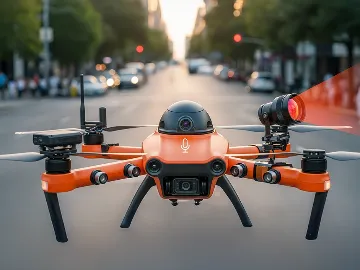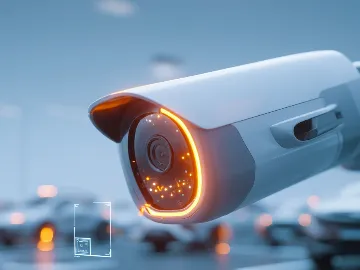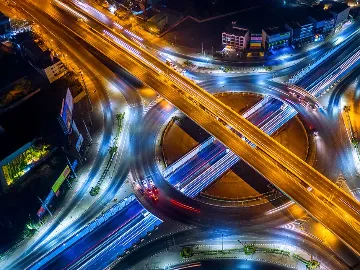When milliseconds matter, such as in automated defect detection on a production line or real-time customer behavior analysis in retail, the delays introduced by transmitting data to the cloud and waiting for a response can result in missed opportunities. These delays not only affect efficiency but can also have profound safety implications.
Let's turn to a solution that addresses these challenges directly: edge computer vision. Processing data at the source-on the devices or near the network's edge-rather than relying solely on centralized cloud servers through computer vision development services. Enterprises can achieve near-instantaneous decision-making, drastically reduce bandwidth usage, and enhance data security-keeping sensitive information close to its source.
Understanding edge computer vision
The more efficiently a business can process and act on visual data, the better it can optimize operations, enhance security, and deliver real-time insights. Edge computer vision refers to deploying computer vision algorithms on edge devices rather than leaning on remote servers or cloud infrastructure. It enables the processing and analysis of visual data-such as images and videos-directly on edge devices like cameras, sensors, and IoT devices, close to where it is captured.
Core components of edge computer vision:
- Edge devices that capture and process visual data. Examples include smart cameras, drones, mobile phones, and industrial sensors. These devices have the necessary hardware to perform complex computations locally, such as GPUs, FPGAs, or ASICs.
- Computer vision algorithms that analyze visual data to extract meaningful information. Typical tasks include object detection, image classification, facial recognition, and anomaly detection.
- Edge AI models, particularly those based on deep learning, are crucial for performing advanced computer vision tasks. These models are often trained in the cloud but deployed at the edge, where they can operate in real-time.

What essential tasks does edge computing computer vision perform to unlock the potential of visual data? Once the appropriate edge devices and algorithms are selected, the following steps are typically involved:
- The first step is capturing visual data through cameras, sensors, or other imaging devices. The edge device must efficiently handle the initial data acquisition to ensure the system can process it immediately.
- After acquisition, the raw visual data needs to be processed. This step involves applying algorithms to clean, filter, and prepare the data for analysis. Edge devices equipped with specialized AI chips perform these tasks in real-time, transforming raw data into a structured, easily analyzed format.
- Feature extraction is the process of specifying attributes within the visual data relevant to the task at hand. This step reduces the complexity of the data, focusing on the most pertinent information and making subsequent analysis more efficient.
- The hallmark is its ability to analyze data in real-time. During this stage, Machine Learning models and advanced algorithms are used to extract features and generate actionable insights.
- Finally, the insights gained from the real-time analysis must be translated into actions. Edge CV systems can automate responses, such as triggering alarms, adjusting machinery, or redirecting autonomous vehicles.
Learn more: Why Generative AI at the edge is the next big tech move
Compare Machine Vision and Computer Vision – choose the right technology for your needs!


Success!

Use cases of edge computer vision across industries
1. Manufacturing
Edge detection computer vision utilizes cameras and sensors strategically placed along the production line to monitor products. The visual data captured from these devices is processed locally using AI algorithms designed to detect anomalies, such as surface imperfections, dimensional inaccuracies, or assembly errors. Moreover, adjusting production parameters on the fly based on real-time feedback helps maintain consistent quality standards.
In some setups, computer vision works alongside IoT sensors (like those measuring temperature or pressure) to provide a comprehensive view of equipment health. This integration enhances the accuracy of predictions and helps target maintenance efforts more effectively.
Automatical computer vision edge detection can identify whether workers wear the required personal protective equipment such as helmets, gloves, and safety glasses. If the system determines a worker without the proper gear, it can immediately alert supervisors to intervene. Edge cameras in high-risk areas can monitor for hazards such as spills, machine malfunctions, or unauthorized access to restricted zones. These systems can detect and report real-time issues, allowing for rapid response to prevent accidents.

Related: Computer vision in manufacturing: What, why, and how?
2. Retail
Edge-based cameras and sensors can track customer movements, analyze foot traffic patterns, and observe how shoppers interact with products. This data gives retailers valuable insights into customer preferences, helping them optimize store layouts, adjust product placements, and tailor marketing strategies to boost sales. For instance, if edge-based systems detect that customers frequently dwell in a particular store section, retailers can use this information to highlight promotional items in that area.
Effective inventory management is crucial for retail operations, and as detailed in this guide to image recognition for retail, stockouts or overstock situations can lead to lost sales and increased costs. Edge computing computer vision enables real-time inventory management by integrating vision systems with edge-based processing capabilities. Cameras and sensors placed in storage areas, on shelves, and at checkout points continuously monitor stock levels, detect misplaced items, and track the flow of goods.

In this case, we helped the client streamline inventory management for more warehouses by modernizing their logistics platform. Our team introduced microservices architecture and DevOps best practices and implemented several advanced technologies, including ML, AI, NLP, computer vision, etc.
Keep reading: Exploring computer vision in retail: Use cases
3. Healthcare
Edge AI devices, such as portable imaging systems and smart medical devices, can process high-resolution images locally, enabling faster diagnostics. For example, a portable ultrasound machine with edge computing capabilities can analyze scans in real time, providing immediate feedback to healthcare providers.
Medical stakeholders benefit from edge computing that supports wearable health monitors and smart home sensors. It can easily continuously track vital signs and other health indicators, processing the data locally before transmitting only the most critical information to healthcare providers. A wearable device that monitors heart rate and oxygen levels can alert the patient and their healthcare provider if it detects abnormalities, allowing immediate action.
Edge devices can power AR systems that overlay critical information onto a surgeon's field of view during an operation. For instance, real-time analysis of imaging data can highlight vital structures or guide incisions, helping surgeons navigate complex procedures with greater precision.
Read more about: Computer vision in healthcare: trends, use cases, and reasons to adopt
4. Smart cities
Edge-based vision systems enable immediate traffic flow, congestion, and incident analysis. Cameras installed at intersections and along roadways capture visual data, which is processed locally to monitor vehicle movement, detect accidents, and assess traffic density. This real-time data allows city authorities to adjust traffic signals dynamically, reroute vehicles to alleviate congestion, and respond swiftly to incidents, such as accidents or road obstructions.
In addition to traffic management, cameras deployed across the city can monitor public spaces, such as parks, streets, and transportation hubs, for suspicious behavior or unauthorized activities. For example, edge-based surveillance cameras can monitor for hazardous situations, such as vehicles running red lights or pedestrians crossing in unsafe areas, and trigger alerts to authorities.
Edge devices equipped with cameras and sensors can monitor pollution levels in real time, analyzing visual data to detect pollutants or changes in air quality. Enterprises can use the information to trigger alerts, implement traffic restrictions, or take other actions to mitigate environmental impact.
5. Autonomous vehicles
Detecting and classifying objects in real-time is fundamental to autonomous vehicle safety. These vehicles must constantly identify pedestrians, other cars, road signs, obstacles, and unexpected hazards, often in complex and unpredictable environments.
N-iX has helped Redflex, an Australian-based company that develops intelligent transport solutions, increase its market presence with a new traffic management solution. Our team created a solution using computer vision and Deep Learning to recognize an offender in front of the wheel and prevent accidents on the road. The solution boasts an impressive accuracy of 88% for seat belt verification and ~91% for distracted driving identification.
Keep reading: Increasing market reach with traffic management and computer vision
Computer vision systems enable Advanced Driver Assistance Systems to process real-time visual data from multiple cameras and sensors around the vehicle. This data detects and classifies objects within milliseconds, allowing the car to react appropriately-whether slowing down for a pedestrian, stopping for a red light, or navigating around an obstacle.
Autonomous vehicles continuously monitor lane markings using computer vision to ensure they stay within their designated lane. These systems can adjust steering and speed in real-time to maintain lane position, even in challenging conditions like sharp turns or when lane markings are faded.
Explore more in detail: computer vision use cases
6. Agriculture
Edge-based cameras and sensors installed in the field can continuously monitor crops for signs of stress, disease, or nutrient deficiencies. Analyzing images of the crops in real time, edge devices can detect issues such as discoloration, wilting, or unusual growth patterns, enabling farmers to take immediate corrective actions.
Equipped with cameras and specialized algorithms, edge devices with computer vision can scan crops for signs of pest infestations, such as leaf damage or insect presence. These systems can identify specific pests and assess the severity of the infestation.
Edge computer vision systems installed on harvesting machines can identify ripe crops ready for picking, guaranteeing that only the best produce farmers harvest. These systems can distinguish between crops based on size, color, and ripeness, enabling selective harvesting that maximizes quality. These systems can detect defects, such as bruising or discoloration, and sort produce according to size and quality, streamlining the post-harvest process.
Learn more about: Computer vision in agriculture: A complete guide
Key challenges of edge computer vision and their solutions

Below, we explore the challenges faced in deploying edge computer vision and how N-iX addresses these challenges.
Computational limitations of edge devices
Edge devices, such as cameras and sensors, often have limited processing capacity and memory, slowing the execution of complex computer vision algorithms. These limitations become particularly acute when real-time processing is required, such as in high-resolution video analytics or advanced object detection tasks.
Our solution: N-iX implements advanced model optimization techniques like pruning, quantization, and knowledge distillation, ensuring that even resource-intensive models can run efficiently on edge devices.
Managing data consistency
Maintaining data consistency between edge devices and cloud servers is challenging, especially when dealing with intermittent connectivity, high data volumes, or asynchronous processing. Discrepancies in data synchronization can lead to inaccurate insights, delays in decision-making, and inefficiencies in operations, particularly in distributed environments where edge devices operate independently.
Our solution: We employ a robust data aggregation and synchronization strategy that leverages edge-to-cloud data pipelines optimized for low bandwidth and intermittent connectivity scenarios.
Deployment complexities
Deploying computer vision models to edge devices involves multiple steps, from model training and optimization to actual deployment and continuous monitoring. The complexity further increased when dealing with various edge devices with different hardware specifications.
Our solution: N-iX builds automated deployment pipelines tailored to the specific needs of edge computing environments. These pipelines include tools for continuous integration and deployment (CI/CD). The models are consistently trained, optimized, and deployed across different edge devices.
Security risks
Edge computing environments, especially those with distributed and remote devices, are vulnerable to security threats such as unauthorized access, physical tampering, and cyberattacks. Ensuring the security of the edge devices and the data they process is critical, particularly in industries where data integrity and confidentiality are paramount.
Our solution: N-iX prioritizes security by implementing a multi-layered defense strategy for edge computing environments. The process includes deploying secure boot processes and using hardware-based security modules, such as TPMs (Trusted Platform Modules), to protect against unauthorized modifications. The team also ensures that all data processed on edge devices is encrypted at rest and in transit, safeguarding it from potential breaches.
High-volume data streams
In many edge computing applications, especially in environments like smart cities, transportation, and industrial automation, edge devices are required to handle high-volume, real-time data streams. This data often comes from multiple sources and must be processed instantaneously to provide actionable insights. These data streams are processed efficiently without overwhelming the edge device's computational resources or causing bottlenecks.
Our solution: We implement a scalable data processing architecture that leverages edge orchestration and data partitioning techniques. The team designs custom solutions that distribute the data processing load across multiple edge nodes.
Wrapping up
Edge computer vision brings powerful data processing capabilities directly to where they're needed most-in real-time, at the edge. By processing data right where it's generated, edge computing enables real-time decisions, bolsters security, and cuts costs-benefits enterprises can't overlook. Imagine being able to catch a defect on your production line the moment it happens or ensuring patient data remains secure while delivering faster care. These are the advantages that edge computing brings to the table.
At N-iX, we have delivered over 60 data science and AI projects and have over 200 data, AI, and ML experts on our team. We have been acclaimed as a rising star in data engineering by ISG, a leading global technology research and advisory firm. We provide comprehensive computer vision consulting and development services, from strategic discovery and project planning to technical implementation, solution rollout, and continuous maintenance within CV outsourcing.
Have a question?
Speak to an expert




